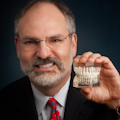Look at me, take a deep breath, tissue to the needle, and slow, slow, slow. What are we talking about? Painless injections.
Are your injections completely painless? (“Oh, yes, I give totally painless injections.”) Be brave enough to ask your staff and, more importantly, your patients. Watching your patient’s eyes will tell the whole story. You think you give painless injections. You use topical, the Wand, VibraJect, and perhaps other devices. But you really don’t need any of those things. We’re going to talk about a method I innovated out of a personal need to provide totally painless injections. I call it the number one practice-builder.
As a child, I was a dental phobic. When I was 5, I had a terrible experience. Some of your patients have had negative dental experiences, so how can we expect them to be relaxed and comfortable in our practice?
Also by Jeffrey Hoos:
What does patient comfort mean?
Why it's not just patients who need to say "yes" to treatment
One of the most painful things in the world had happened to me at that appointment as a 5-year-old. I had a tooth removed with novocaine, but it didn’t work because the tooth was infected. I was subjected to a horrible and unnecessary dental experience that profoundly affected me.
When I met Dr. Irving Paul in Bangor, Maine, he changed my life. He helped me overcome my dental phobia by creating trust and an environment that made me want to be a dentist from the age of 6. He showed me compassion and converted me from a dental phobic to someone who told everyone, “I want to be a dentist.”
Years later, I fulfilled my dream and got into Tufts. I decided I wanted to learn how to give painless injections. The university offered a course in hypnosis, and I thought this might be the answer. I learned a lot about relaxation, and to this day I hypnotize myself to sleep at night. Hypnosis teaches you the important tool of overcoming the will of someone else. The reason for learning hypnosis is to create a situation where patients will be totally relaxed and therefore completely comfortable. There are lots of ways we can make our patients comfortable—maybe it’s using nitrous oxide or oral sedation; some patients may even be so phobic that they need to have IV sedation.
Think about the complexity of the nervous system. It’s made up of two parts: the sympathetic and the parasympathetic nervous systems. The parasympathetic system allows you to relax, which is necessary to experience a painless injection, and the sympathetic system gets you ready for battle. Your body dumps epinephrine into your system and lots of things happen to prepare you for that battle.
But what if you aren’t relaxed, but instead wound up and ready to fight the enemy? Think about being asked to give a speech you aren’t prepared for. You’re nervous, your mouth is dry, and you feel shaky. Think about your patients who are nervous. When they ask to go to the restroom, it’s because their sympathetic nervous system has taken over. They feel like they want to leave the dental office.
How many times have you been unable to numb a nervous patient? Their acid base balance has changed because the sympathetic system has taken over. We need patients to be relaxed, but they can’t be in an uncomfortable environment. We need the parasympathetic nervous system to be in charge.
We also need to use instruments or needles that are very sharp. This may seem intuitive, but if you use a needle once, it’s no longer as sharp. When you go into a different site that isn’t numb (like when you’re numbing many teeth), the patient is going to feel it.
How does this all come together? Are you doing an infiltration or a block? It doesn’t matter with this “painless injection” method. When you combine distraction, hypnosis, rapid movement of the tissue to the needle, going slow as you inject, and the right instrumentation, you can give painless injections.
Practice building 101 is all about putting the pieces together, and painless injection is an important part of it.
Editor's note: This article appeared in the July 2022 print edition of Dental Economics magazine. Dentists in North America are eligible for a complimentary print subscription. Sign up here.
About the Author
Jeffrey C. Hoos, DMD
Jeffrey C. Hoos, DMD, a 1978 graduate of the Tufts University School of Dental Medicine, started his private practice as a one-operatory walk-up and grew it to a four-doctor practice with 25 staff members. He lectures on innovative techniques that balance the art, science, and business of dentistry. He is one of the first general dentists to be Brånemark certified for implant placement, and his office has become a teaching center for restorative and implant dentistry. Contact him at [email protected].

